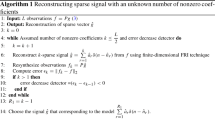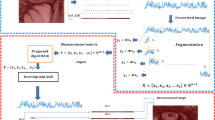Abstract
Traditionally, annihilating filter approach (a.k.a Prony’s approach), universal finite rate of innovation (FRI), and compressed sensing algorithms have been presented to solve the sparse reconstruction problem when the measurement matrix has Fourier bases. However, annihilating filter approach requires computing the polynomial roots of the annihilating filter, and this fact yields an unstable recovery of sparse signal in the high noise environment. In this paper, we present a polynomial root-free annihilating filter approach for reconstructing sparse signals based on the padding of missing measurement values to acquired measurements. The method accomplishes complete reconstruction accuracy of sparse signals in the noiseless environment. Moreover, the superior reconstruction accuracy of the proposed root-free annihilating filter approach, in comparison with the traditional annihilating filter approach and universal FRI, is proved by experimental simulations in the existence of a low signal-to-noise ratio.







Similar content being viewed by others
Availability of data
Not applicable.
References
T. Blu, P.L. Dragotti, M. Vetterli, P. Marziliano, L. Coulot, Sparse sampling of signal innovations. IEEE Signal Process. Mag. 25(2), 31–40 (2008)
M. Brajović, I. Orović, M. Daković, S. Stanković, On the parameterization of hermite transform with application to the compression of qrs complexes. Sig. Process. 131, 113–119 (2017)
J.A. Cadzow, Signal enhancement: a composite property mapping algorithm. IEEE Trans. Acoust. Speech Signal Process. 36(1), 49–62 (1988)
S.S. Chen, D.L. Donoho, M.A. Saunders, Atomic decomposition by basis pursuit. SIAM Rev. 43(1), 129–159 (2001)
I. Dassios, D. Baleanu, Optimal solutions for singular linear systems of caputo fractional differential equations. Math. Methods Appl. Sci. 44(10), 7884–7896 (2021)
I. Dassios, K. Fountoulakis, J. Gondzio, A preconditioner for a primal-dual newton conjugate gradient method for compressed sensing problems. SIAM J. Sci. Comput. 37(6), A2783–A2812 (2015)
I.K. Dassios, Analytic loss minimization: theoretical framework of a second order optimization method. Symmetry 11(2), 136 (2019)
D.L. Donoho, Compressed sensing. IEEE Trans. Inf. Theory 52(4), 1289–1306 (2006)
D.L. Donoho, Y. Tsaig, Fast solution of \( l_{1} \)-norm minimization problems when the solution may be sparse. IEEE Trans. Inf. Theory 54(11), 4789–4812 (2008)
D.L. Donoho, A. Maleki, A. Montanari, Message-passing algorithms for compressed sensing. Proc. Nat. Acad. Sci. 106(45), 18914–18919 (2009)
P.L. Dragotti, M. Vetterli, T. Blu, Sampling moments and reconstructing signals of finite rate of innovation: Shannon meets strang-fix. IEEE Trans. Signal Process. 55(5), 1741–1757 (2007)
M.A. Hadi, S. Alshebeili, K. Jamil, F.E.A. El-Samie, Compressive sensing applied to radar systems: an overview. SIViP 9, 25–39 (2015)
A. Hormati, M. Vetterli, Annihilating filter-based decoding in the compressed sensing framework. In: Wavelets XII, International Society for Optics and Photonics, vol. 6701, p. 670121 (2007)
M. Lustig, D. Donoho, J.M. Pauly, Sparse MRI: the application of compressed sensing for rapid MR imaging. Magn. Resonance Med.: Off. J. Int. Soc. Magn. Resonance Med. 58(6), 1182–1195 (2007)
I. Maravic, M. Vetterli, Sampling and reconstruction of signals with finite rate of innovation in the presence of noise. IEEE Trans. Signal Process. 53(8), 2788–2805 (2005)
J. Oñativia, Y.M. Lu, P.L. Dragoni, Finite dimensional FRI, in 2014 IEEE International Conference on Acoustics. (Speech and Signal Processing (ICASSP), IEEE, 2014), pp. 1808–1812
P.S. Reddy, B. Raghavendra, A. Narasimhadhan, Approximate finite rate of innovation based seismic reflectivity estimation. Circuits Syst. Signal Process. 43(10), 6399–6414 (2024)
S. Song, J. Shen, Exponential-reproducing-kernel-based sparse sampling method for finite rate of innovation signal with arbitrary pulse echo position. Circuits Syst. Signal Process. 38(3), 1179–1193 (2019)
L. Stanković, E. Sejdić, S. Stanković, M. Daković, I. Orović, A tutorial on sparse signal reconstruction and its applications in signal processing. Circuits Syst. Signal Process. 38(3), 1206–1263 (2019)
P. Sudhakar Reddy, A. Premkumar, B. Saikiran, B.S. Raghavendra, A.V. Narasimhadhan, Finite rate of innovation signal reconstruction using residual neural networks. in 2020 IEEE 4th conference on information & communication technology (CICT), IEEE, pp. 1–6 (2020)
P. Sudhakar Reddy, B.S. Raghavendra, A.V. Narasimhadhan, Magnetic resonance image reconstruction by nullspace based finite rate of innovation framework. in Proceedings of the twelfth Indian conference on computer vision, graphics and image processing, pp. 1–5 (2021)
P. Sudhakar Reddy, B. Raghavendra, A. Narasimhadhan, Universal discrete finite rate of innovation scheme for sparse signal reconstruction. Circuits Syst. Signal Process. 42(4), 2346–2365 (2023)
P. Sudhakar Reddy, B.S. Raghavendra, A.V. Narasimhadhan, Sparse-prony fri signal reconstruction. Signal Image Video Process. 17(7), 3443–3449 (2023b)
R. Tibshirani, Regression shrinkage and selection via the lasso. J. R. Stat. Soc. Ser. B: Stat. Methodol. 58(1), 267–288 (1996)
J.A. Tropp, A.C. Gilbert, Signal recovery from random measurements via orthogonal matching pursuit. IEEE Trans. Inf. Theory 53(12), 4655–4666 (2007)
J.A. Urigüen, T. Blu, P.L. Dragotti, Fri sampling with arbitrary kernels. IEEE Trans. Signal Process. 61(21), 5310–5323 (2013)
M. Vetterli, P. Marziliano, T. Blu, Sampling signals with finite rate of innovation. IEEE Trans. Signal Process. 50(6), 1417–1428 (2002)
H.C. Xin, B.Z. Li, X. Bai, A novel sub-nyquist FRI sampling and reconstruction method in linear canonical transform domain. Circuits Syst. Signal Process. 40(12), 6173–6192 (2021)
J. Zhang, S. Chang, L. Zhang, Y. Su, X. Fu, Sparse wavelet transform for underwater acoustic image compressed sensing. in 2018 OCEANS-MTS/IEEE Kobe Techno-Oceans (OTO), IEEE, pp. 1–4 (2018)
Author information
Authors and Affiliations
Corresponding author
Ethics declarations
Conflict of interest
Authors declare that they have no Conflict of interest.
Additional information
Publisher's Note
Springer Nature remains neutral with regard to jurisdictional claims in published maps and institutional affiliations.
Rights and permissions
Springer Nature or its licensor (e.g. a society or other partner) holds exclusive rights to this article under a publishing agreement with the author(s) or other rightsholder(s); author self-archiving of the accepted manuscript version of this article is solely governed by the terms of such publishing agreement and applicable law.
About this article
Cite this article
Sudhakar Reddy, P., Raghavendra, B.S. & Narasimhadhan, A.V. Root-Free Annihilating Filter Method for Sparse Signal Reconstruction. Circuits Syst Signal Process 44, 670–683 (2025). https://doi.org/10.1007/s00034-024-02871-3
Received:
Revised:
Accepted:
Published:
Issue Date:
DOI: https://doi.org/10.1007/s00034-024-02871-3




